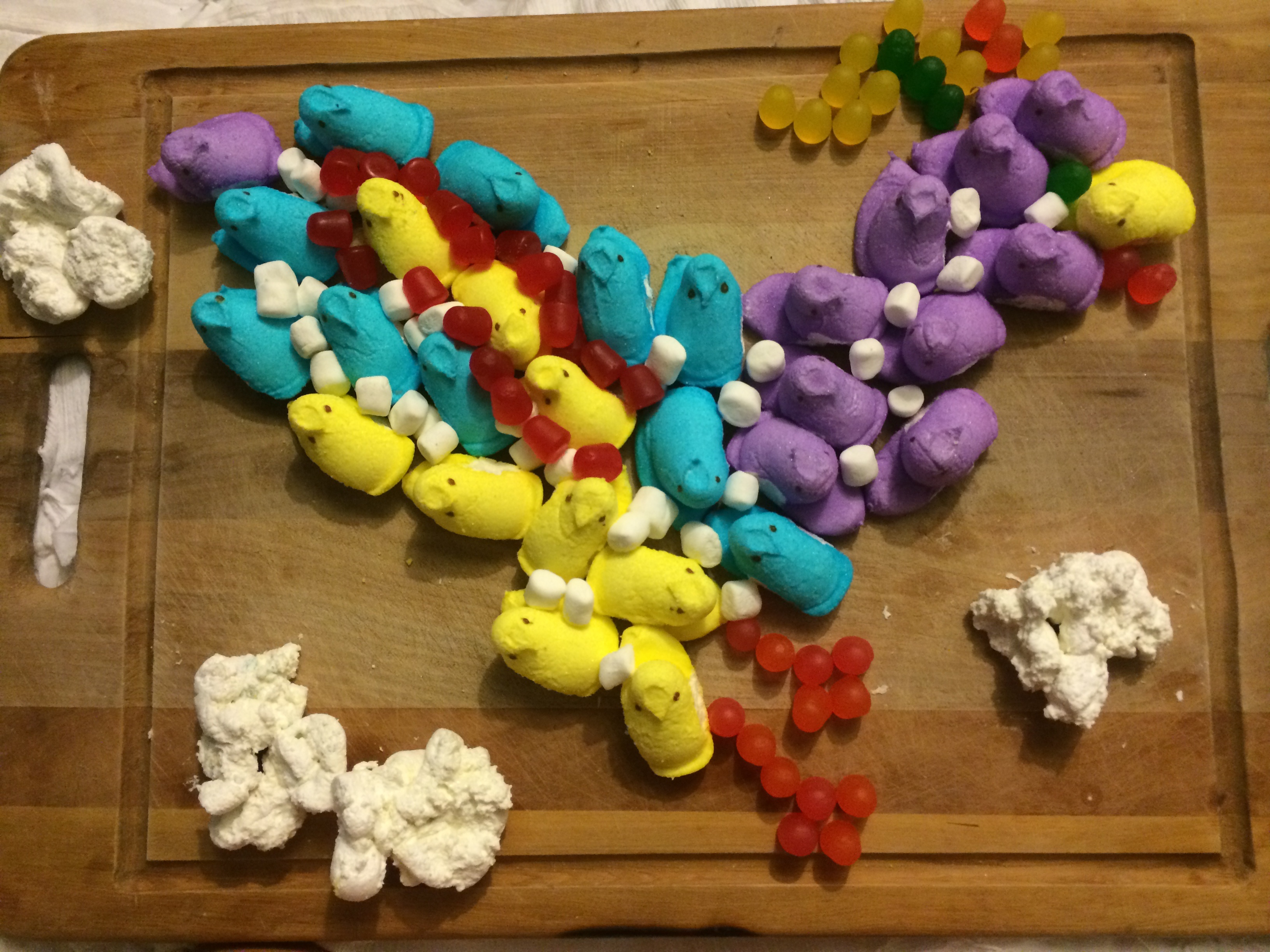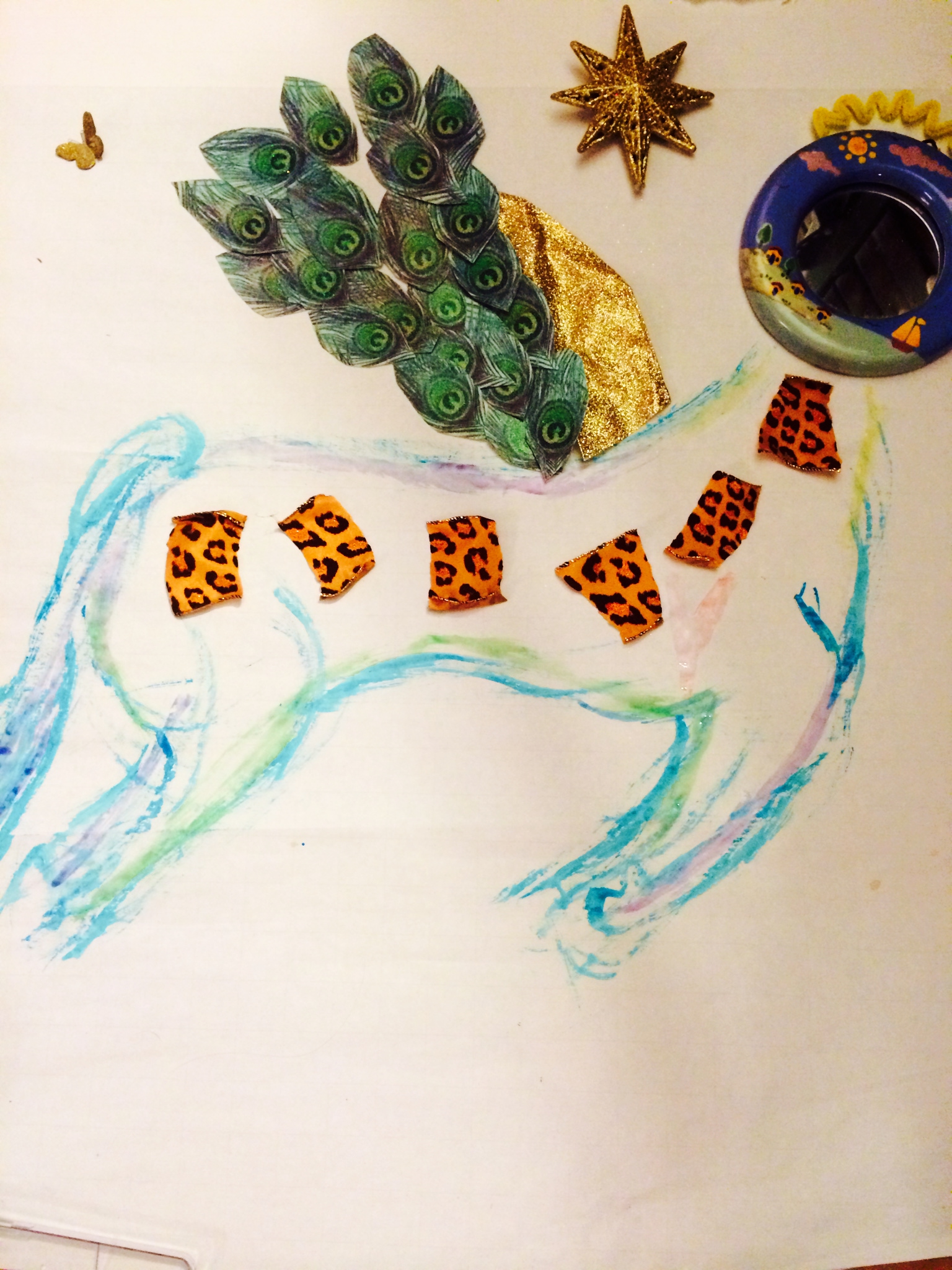Working on these art projects has been a pleasure and helped me to appreciate the intricate art pieces we have seen in class. I am not an artist in the classical sense, but I do believe that each one of us is an artist in our own way. Expressing myself in this class has made the topics and themes more memorable. Fifty years from now, I really do think I will be able to recall the art projects I made for this class and the associated themes. One of my primary reasons for taking this class was to think about alternative teaching methods, and I can honestly say that the Cultural Studies Approach mixed with the use of individual expression of classroom lectures and readings has been extremely effective. In my artwork I incorporate and/or was inspired by the following five themes: (1) connection to one’s own experience and context, (2) Sufi/mystical understanding of Islam, (3) role of women in Islam, (4) unity and (5) importance of recitation and the spoken word.
While listening to lectures or doing the readings for class, I would connect with certain themes and topics on a personal level (spiritually, emotionally, or simply out of pure curiosity), and I would immediately feel the inspiration setting in with ideas popping into my head about how I could express my connection to a particular reading or theme in an art project. In a more typical class, I would not have had this opportunity for such self-expression beyond the pure intellectual excitement. Just as the Islamic artists were able to go beyond the intellect to connect with the Divine on a deeper level through art, I also was given this opportunity through these projects. What I really loved was that we were allowed to connect the artwork to our own experience even if that expanded into our own religious/spiritual practice. Because of this, I incorporate chakras in my “Ascension to the Divine” piece because I see parallels between chakras and the idea of cleansing one’s ego and self to be more ready, pure and able to meet the Divine. Also, in the video I make where I am able to actually practice seeing God in my daily life just as a verse in the Qur’an (2:164) tells us to do was expansive in that I felt that I was practicing my own religion (Christianity) while aligning with my interpretation of this particular verse. Finally, in my last piece inspired by Conference of the Birds, I saw a connection between the teachings in the story and a verse in the Bible and was able to connect this in the artwork and explanation of it. I really appreciate the openness of these projects in allowing us to have the freedom to think like an artist without worrying about whether our interpretation is right or wrong because in the end, we are creating the art from our own context and perspective, bringing the Cultural Studies Method to life.
Every time I study Islam, I feel the most connected to the mystical Sufi interpretation, which aligns with my more mystically inclined Christian interpretations. Thus, much of my artwork leans toward the Sufi interpretation even if not explicitly. Understanding Islam through what I believe to be its deeper meaning – the Batin rather than focusing solely on the Zahir – has enabled my ability to connect with Islam through this artwork. I see so many commonalities between my understanding of God and the Sufi understanding. Najaf Haider, an Indian historian, claimed, “The cornerstone of Sufi ideology is love” and love is a consistent theme in Sufi and more mystically inclined art and poetry (W. Dalrymple). However, amidst the proclamations of love in Sufi writings, specifically Rumi’s, we see constant declarations of pain, struggle, and separation. This language seems to incorporate some of the most important aspects in reaching the final goal – uniting with God in perfect love. This is something I wanted to capture in my artwork – the idea of a journey toward the Divine and the magnificent struggle associated with it. These struggles include: awakening the consciousness to initiate a pathway to the Divine, the pain of separation from society and the material world associated with initiating this pathway (as expressed in my last piece inspired by Conference of the Birds), the struggle experienced while on the pathway both with killing the ego and building other senses and states of consciousness, and the struggle that occurs after uniting with God has taken place.
Of course, as a woman, I am completely fascinated by the portrayal of women in Islam and the interpretations of their role in spirituality. Oftentimes, women seem to be portrayed as a distraction as was brought up in the recitation competitions and whether or not women can recite the Qur’an and in the midst of what genders. Also, the theme comes up in whether or not having a relationship with a woman can bring one closer to the Divine or serve as a hindrance to the Divine. I focus on the man/woman as equal parts of the same whole that need one another in seeking the Divine. This is present in my piece “Human Love to the Divine” where I portray the genders not as a hindrance to one another but rather as potentially mutual spiritual partners for one another on the pathway to the Divine. Of course in class we also discussed the woman (and her body) as a symbol of Islam and as a key part of the discourse surrounding finding the “right” Islam. I do not really portray this in my pieces, but I do appreciate hearing the various feminist and feminine interpretations of the Qur’an, the Sunnah, and the Hadith in comparison to the patriarchal and male-favoring interpretations of the very same passages. In this same line of discussion enters the phenomenon of certain groups, from a wide spectrum of types of Islam, trying to “correct” Islam and bring it back to its pure form. This has been interpreted in a variety of ways, but it always involves some kind of interpretation on how the woman is supposed to dress or behave. It would be interesting to learn more about this phenomenon in other religions and cultures as well to understand if this focus on the woman is common in other movements. We did discuss the creation of the bikini as part of the “liberation” movement of women in the 1960s and 70s, but I am curious to learn how common this focus on the female body has been throughout history and across contexts.
This course has also inspired me to think about unity and what it means in an Islamic context. In one of our discussion sessions, we had a debate over what the term “unity” actually means and how it relates to Islamic art. Is all Islamic art connected only if it pertains to a particular style or is Islamic art connected on a more spiritual level? I tend toward a more spiritual/less rigid definition of unity for both Islamic art and people. This is something I express in several of my pieces. In my art inspired by Conference of the Birds where all of the birds make up one larger being, this theme is quite obvious. The unity of the birds into one Simorgh demonstrates the unity of all people whether or not we are conscious of it. Interestingly, it goes beyond Muslims (with a capital “M”) and incorporates all people (muslims with a small “m” being those who submit and choose to go on the journey). This goes back to my ability to connect the art with my own understandings of life because I also believe that all of humanity, regardless of religious practice, is connected whether or not we are aware of it or not. Also, in the recitation piece, I try to unite with the experience as described by others and begin to understand why recitation seems to unite Muslims around the world and serve as an important spiritual practice for many. Lastly, in the video where I film evidence of God in my daily life, I am not filming things that others are not also united in sharing. They are seemingly normal aspects of life that unite all of us with the additional consciousness of the Divine’s presence within those aspects. However, I can also understand where the idea of unity can cause conflict such as in movements that seek to find the “right” Islam for everyone in an effort to reach a particular perception of unity. Thus, I found it enlightening to think about how a seemingly clear and positive term could be both contested and potentially negative if taken in certain contexts and used for forceful or violent means.
Finally, the importance of recitation, the spoken word and its expression in calligraphy were continuous themes throughout the course that both fascinated me and inspired some of my art. I had not previously made the connection between the difference of the Bible, for instance, and the Qur’an in the sense that the Qur’an was originally a recited piece coming from God and passed on through Muhammad who was asked to recite – “Iqra” being the famous first word ordering Muhammad to recite what he was hearing. This tradition has become an integral part of practicing Islam for many Muslims and is the reason why the Qur’an is not easily translatable into languages other than Arabic. In fact, it has been impossible to recreate the spoken beauty of the Qur’an in other languages. As a child, I memorized verses from the Bible but not with the focus on the Bible’s spoken beauty. Rather the focus was on the content of the verse and how it could be applied to my life and context. It was difficult for me to understand how recitation competitions could be seen as a spiritual practice, especially in a language that reciters may not even understand, until I finally made the connection with the idea that words in the Qur’an and their sounds in themselves are sacred. When I was reciting the Light verse from the Qur’an as one of my art pieces, I felt its beauty and a connection with the verse even though I do not know Arabic. The aesthetic make-up of the Qur’an when spoken aloud is magnificent. I may not have even fully realized this until I did the recitation myself.
I hope that these explanations give you a better understanding of the process and inspiration I experienced in creating each of these art pieces. If only we could use this method for all misunderstandings and conflicts, giving all sides the opportunity to actually experience the context of another in relation to one’s own experience. Studying Islam through art really brought the Cultural Studies Method to life and has inspired me to think about how I could use the method in other education contexts in my own career. I suppose we could call that my ongoing art piece.
Works Cited
W. Dalrymple, “India, The Real Islam.” Time Magazine, July 26-Aug 2, 2004/ vol. 164, no. 4/5.





